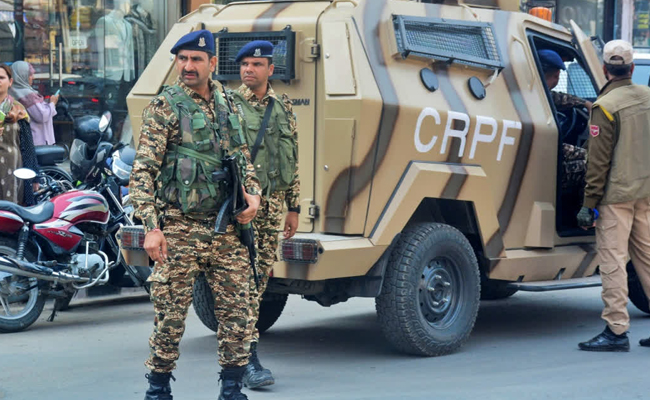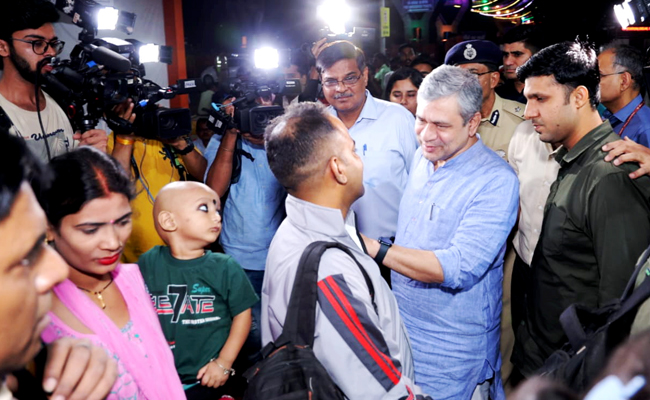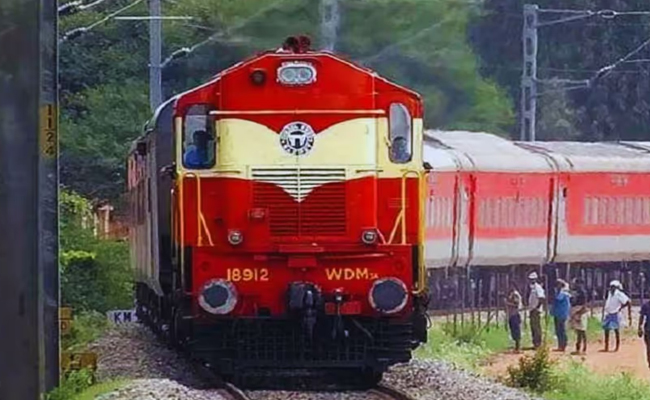Sriharikota, (AP) (PTI): Four years after it broke many hearts, ISRO's Chandrayaan is all set to soar towards the moon in its third expedition on Friday in an attempt to put the country in an elite club of nations that accomplished lunar missions with a soft landing.
'Fat boy' LVM3-M4 rocket will carry Chandrayaan-3 as part of the country's ambitious moon mission as the Indian Space Research Organisation is gearing up for the hugely anticipated launch from this spaceport on July 14. The soft landing on moon's surface is planned for late August.
Chandrayaan-2 failed to achieve the desired soft landing on the moon surface in 2019, leaving the ISRO team dejected. Images of an emotional then ISRO chief K Sivan being consoled by Prime Minister Narendra Modi who was here to achieve the rare feat, remains vivid in the memory of many.
Scientists at the Satish Dhawan Space Centre here, after investing many hours of hardwork, now aim at mastering the technology of soft-landing on the surface of the moon. A success would make India only the fourth country to achieve the feat after the United States, China and the former Soviet Union.
Chandrayaan-3, is the third lunar exploration mission ready for take off in the fourth operational mission (M4) of LVM3 launcher. ISRO is crossing new frontiers by demonstrating soft-landing on the lunar surface by its lunar module and demonstrating roving on the lunar terrain, the space agency said.
The mission is expected to be supportive to future interplanetary missions.
Chandrayaan-3 mission consists of an indigenous propulsion module, lander module and a rover with an objective of developing and demonstrating new technologies required for inter-planetary missions.
With the 43.5 metre tall rocket, scheduled for the lift off from the second launch pad at pre-fixed time at 2.35 pm on July 14, the countdown for the launch is expected to begin on Thursday.
The largest and heaviest LVM3 rocket (formerly GSLV MkIII), fondly called as 'fat boy' by ISRO scientists for its heavylift capability, has completed six consecutive successful missions.
The LVM3 rocket is a composite of three modules -- propulsion, lander and rover (which is housed inside the lander).
Friday's mission is the fourth operational flight of LVM3 which aims to launch the Chandrayaan-3 spacecraft into a Geo Transfer Orbit.
The LVM3 vehicle has proved its versatility to undertake most complex missions including injecting multi-satellites, interplanetary missions among others. It is also the largest and heaviest launch vehicle ferrying Indian and International customer satellites, ISRO said.
The reason to fix the launch window during the month of July similar to Chandrayaan-2 mission (July 22, 2019) is because the earth and moon would be closer to each other during this part of the year.
Friday's mission follows Chandrayaan-2 where scientists aim to demonstrate various capabilities including reaching the orbit of the moon, making a soft-landing on the lunar surface using a lander, and a rover coming out of the lander to study the surface of the moon.
In the Chandrayaan-2 mission, the lander instead of making a soft landing crashed on the surface leading to an unsuccessful attempt by ISRO.
However, this time scientists have left no stone unturned in an effort to ensure smiles in August when the landing is planned.
As the days neared for the launch, the Satish Dhawan Space Centre was bustling with activity as the launch vehicle was integrated into the launch mission complex at the second launch pad recently.
On Tuesday, the 'launch rehearsal' simulating the entire launch preparation and process that lasted for over 24 hours concluded at Sriharikota.
According to scientists, after the lift-off at 2.35 pm on Friday, around 16 minutes after lift-off, propulsion module is expected to get separated from the rocket and would orbit the earth for about 5-6 times in an elliptical cycle with 170 km closest and 36,500 km farthest from earth moving towards the lunar orbit.
The propulsion module along with the lander, after gaining speed would proceed for an over a month long journey towards reaching the orbit of the moon until it goes 100 km above the lunar surface.
After reaching the desired position, the lander module would begin its descent for a soft landing on the south pole region of the moon and this action is expected to take place on August 23 or 24, scientists at ISRO said.
The moon's south pole region has been chosen because the Lunar South Pole remains much larger than that at the North pole. There could be a possibility of presence of water in permanently shadowed areas around it.
The significance aboutChandrayaan-3 mission, unlike its unsuccessful predecessor, is that the Propulsion Module has a payload -- SHAPE -- Spectro- polarimetry of HAbitable Planet Earth which is to study earth from lunar orbit.
ISRO said the SHAPE is an experimental payload to study the spectro-polarimetric signatures of the Earth in the near-infrared wavelength range.
Apart from the SHAPE payload, the Propulsion Module's main function is to carry the Lander Module from launch vehicle injection orbit to till lander separation.
The lander module after landing on the surface of the moon has payloads including RAMBHA-LP which is to measure the near surface plasma ions and electrons density and its changes, ChaSTE Chandra's Surface Thermo Physical Experiment -- to carry out the measurements of thermal properties of lunar surface near polar region and ILSA (Instrument for Lunar Seismic Activity) to measure seismicity around the landing site and delineating the structure of the lunar crust and mantle.
The Rover, after the soft-landing, would come out of the lander module and study the surface of the moon through its payloads APXS - Alpha Particle X-Ray Spectrometer - to derive the chemical composition and infer mineralogical composition to further enhance understanding of lunar surface.
Rover, which has a mission life of 1 lunar day (14 Earth days) also has another payload Laser Induced Breakdown Spectroscope (LIBS) to determine the elemental composition of lunar soil and rocks around the lunar landing site, ISRO said.
Let the Truth be known. If you read VB and like VB, please be a VB Supporter and Help us deliver the Truth to one and all.
Sundargarh (Odisha) (PTI): Six people were killed and five others injured after a vehicle in which they were travelling rammed into a truck in Odisha's Sundargarh district early on Saturday, police said.
The accident occurred near Gaikanapali area under the Hemgiri Police Station limits when the passenger-carrying van hit the truck from behind, a senior officer said.
"Six members of a 'kirtan' group died on the spot, and five others were injured. Maybe, the accident occurred due to fog in the area," he said.
The 'kirtan' party went to Chakkplai village for a programme on the occasion of Diwali, and the accident took place when they were returning to their villages.
The deceased people belonged to Kandagoda and Samarpinda villages in the district.
The injured persons were admitted to a local hospital, the officer said.
Local people blocked the road, demanding ex gratia for the victims' families.





